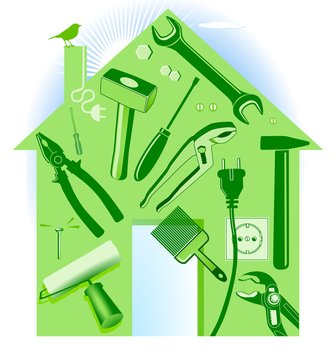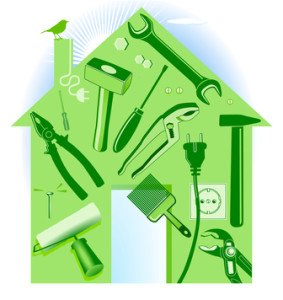
Hints for Home Owner’s: Annual Home Maintenace Ideas
Like most of us, the average person starts the new year off with a list (or maybe just one,) of new year’s resolutions that usually include personal health and growth type’s of goals. But many of us forget to include goals that pertain to other things of great importance… like our homes. January is a perfect time to accomplish some of those tasks around the house, or check up on some general maintenance of your home.
I’ve compiled a list from MSN.Com to help you get started: 1. Spiff up the front entry. One way to stay on top of your home’s maintenance and protect your investment is to look at it as though you’re a stranger considering it for purchase. Perform repairs as the need arises and try each year to add a little to the home’s attractiveness on the outside. One good way to boost curb appeal, as real-estate agents call it, is to make the entrance more appealing. Once the weather is dry, check steps, decks and porches for wood rot and peeling paint. Repaint porch steps and railings yearly with durable deck paint. Wash winter grime and dust off the front door and door frame. Repaint or stain the front door to protect wood doors and give the whole home a little face lift. Consider using a fun accent color such as barn red, black, hunter green, navy blue or gold, depending on the other colors on your home’s exterior. You may want to add built-in planters to a deck or front porch and change the plants with the season.
2. Book a home inspector. The only time most folks meet a home inspector is during the sale of their home. But by then, you’re learning about troubles too late. To stay on top of your home’s maintenance and head off expensive repairs, hire a home inspector to scrutinize your home from top to bottom. Cost: $200 to $400. Tag along on the inspection so you can see any problems for yourself and learn about your home by asking questions. The inspection will give you either peace of mind that everything’s in good shape or a list of chores to be done. Ask the inspector to help you prioritize the repairs. (If you need a recommendation I have a guy… email me.)
3. Banish household smells
- Clean the garbage disposal. It’s good to get in the habit of doing this monthly. Pour a cup of vinegar into an ice cube tray, fill up the rest of the tray with water and stick it in the freezer. When the solution has frozen, pop out the vinegar ice cubes and place them in the disposal. Turn it on and let the ice cubes scrub the disposal as they are ground up. The vinegar will remove accumulated grease and eliminate odors coming from the disposal. Clean all drains, including the disposal, two or three times a year by pouring in equal parts salt, baking soda and vinegar, followed about 30 seconds later by two quarts of boiling water. Give the mixture a chance to work overnight to clear clogged drains. (Learn more: “Drains 101: Skip the plumber and tackle these tasks yourself.”)
- Clean or replace garbage cans and pails. Check garbage containers inside and out for cracks and breakage. Replace cracked or broken outdoor cans and use bungee cords to keep lids closed tightly. Take the kitchen garbage pail outside, sprinkle in a half-cup of baking soda and fill the can with hot water. Let sit for an hour, then dump out the water and use spray cleanser to wipe down the can inside and out. Dry it thoroughly before putting it back in the kitchen and inserting an empty garbage bag. Clean the refrigerator by removing everything and washing down the inside with hot water and baking soda.
- Eliminate bathroom and kitchen smells. Trapped moisture encourages smelly mildew, mold and rot, which can create odors in the kitchen, laundry and bathrooms. Thoroughly inspect each of these rooms for cracks and breakage in grout and caulking that let water seep behind tile and flooring. Learn how to replace cracked or chipped tile grout and read “How to caulk your bathtub neatly.” Check appliances for plumbing leaks by looking for moisture under or around sinks, tubs, washer, dryer, shower and toilets. Check for toilet leaks: Add a few drops of food coloring into the tank (not the bowl) of a toilet. Don’t flush. Come back in an hour to see if any of the color has reached the toilet bowl. If it has, you probably need to replace the flapper in the tank. If water is collecting around the base of the toilet, the seal – the wax gasket between the toilet and floor – may have failed and need to be replaced.
4. Install two simple water-saving devices:
- Toilet-tank displacers. If you’ve been meaning to try some of those water-saving tricks you’ve read about, here’s an easy one to start with: Older toilet tanks hold a lot more water than they need for flushing. Cut water usage by displacing some of this tank water. The Alliance for Water Efficiency cautions that this is a good idea only for toilets with a rated flush volume of 3.5 gallons or more. (Look for information about your toilet’s rated flush volume on a label behind the seat hinge or stamped into the porcelain of the back of the tank. If you can’t find it, ask your water utility to help while conducting a no-charge home audit of your water usage. Or contact the toilet’s manufacturer for help identifying your model’s specifications.) Here’s how to displace water in the tank: Fill a clean, half-gallon plastic milk bottle with water and add some small stones to help weight it down, then lower the bottle into the tank, being careful to avoid the working parts. Or, purchase and install a Toilet FlushLess water displacement bladder bag. But whatever you do, don’t – as some advise – put bricks in the toilet tank. They’ll crumble and the sediment can wreck a toilet.
- Aerators. Kitchen and bathroom faucets consume a great deal of water. Trim your home’s water usage by installing aerators in the faucet heads. Some shower heads accept aerators, too. Aerators mix air into the water to maintain good water pressure while reducing the amount of water flowing through the faucet. They cost $2 to $3 at a hardware store. Some water utilities give them free to customers. To install, screw the aerators onto the faucet tip. If you already have aerators on your faucets, remember to remove them annually to clean off any mineral deposits that can clog the screw-on screen and interfere with your water flow. Just toss and replace badly clogged aerators.
5. Inspect and repair drywall. Once a year, walk around the interior of your home with a spatula and container of lightweight putty (ask at the hardware store for help choosing products). Inspect the walls for dings, nail holes and gouges. Use the spatula to smooth putty into holes and scrape the repaired spot even with the wall. Return the next day and touch the putty to see if it has dried. Once dry, gently rub it with fine-grained sandpaper so the patch will be smooth and even with the wall. Gently retouch the spot with primer, then with paint. If a repainted area shows up when dry, you may have to repaint the entire wall. (For bigger problems, read “How to fix a hole in the wall.”)
Picking all or even a few of these tasks will keep your home and your self in good health. You may give up on that diet or gym membership, but don’t give up on your home! After all, home is where the heart is.
If you have some simply yearly home maintenance tips, I’d love to hear from you,

